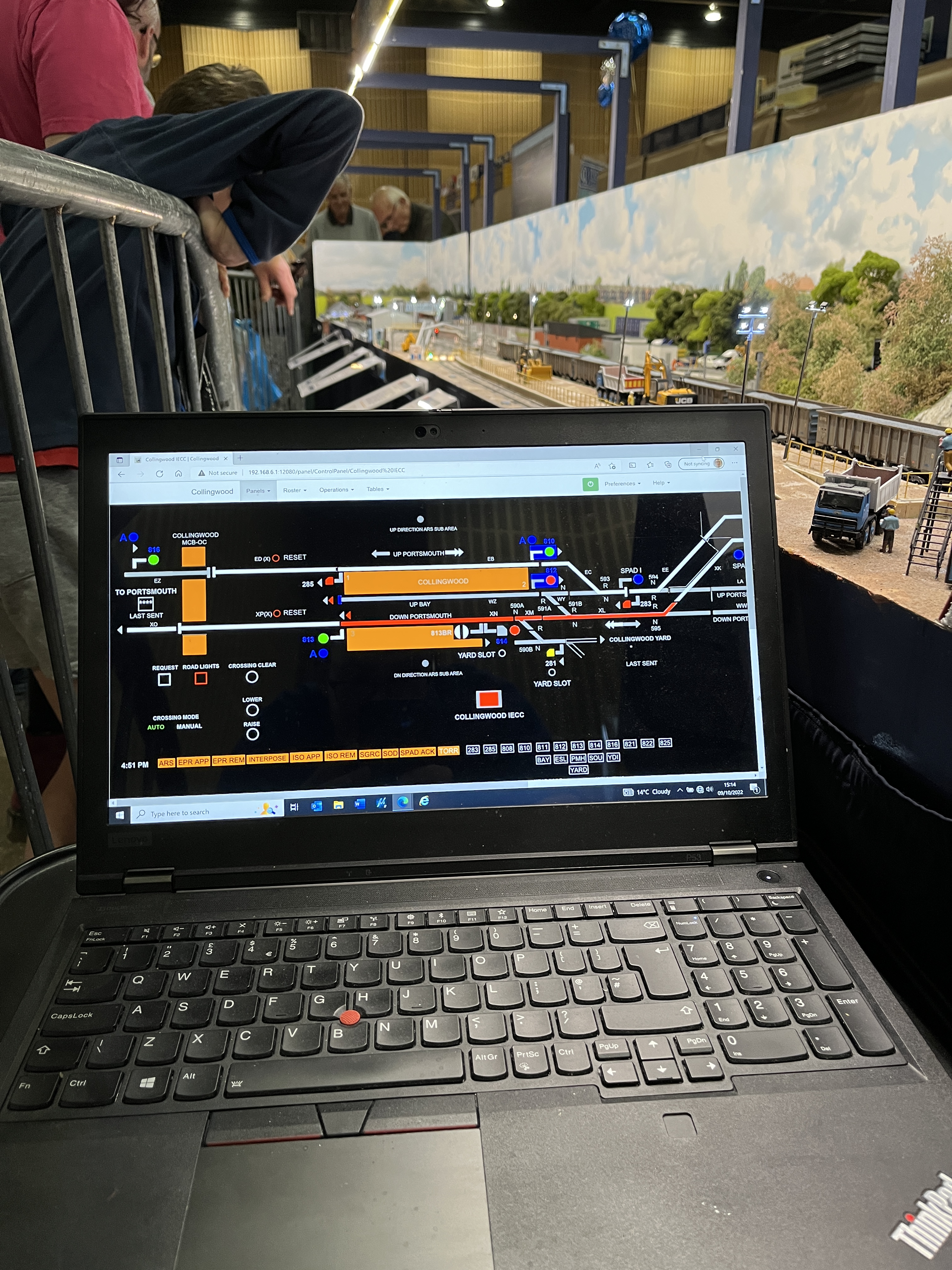The route calling sub-process, along with the point calling sub-process, is where the bulk of the interlocking to prevent conflicting routes being set is performed.
For the purpose of explaining everything, I’ll use route CD810 B(M), a ‘Main’ class route from CD810 to CD822
The first thing for the route calling process to check when trying to get a route ‘reverse’ is that the signaller has chosen a legitimate route. For this, it checks that the correct entrance and exit buttons for the route have been pushed (the Push Button Interlocking described in last weeks post has already ensured that they have been pushed in the right order).
All routes from a signal, regardless of number or class are provide with a single-entry button, the exit button being the one where the signaller makes a choice as to which route they wish to set, there being a separate button for each class of route.
| Panel Symbol | Name | Description |
|---|---|---|
 | ‘Main’ Route | Route from one main signal to the next that allows running movements. It requires the section and overlap to be clear. |
 | ‘Warner Route’ | Route from one main signal to another using a restricted overlap and where the ‘exit’ signal is at red. |
 | ‘Call-On’ Route | A route that is provided to permit a train movement into a section known to be occupied. |
 | ‘Shunt’ Route | A route used for low-speed non-passenger movements. |
 | ‘POSA’ Route | A route for use during lineside signalling failures to instruct the driver to enter a Signal Section and proceed at such a speed that the train can be stopped short of any obstruction. |
***It should be noted that for ‘real-life’ VSCS Workstations, the entrance button and main exit button shown on Collingwoods VSCS do not exist, the signaller simply clicking on the signal post performs the same action. This is due to a limitation with JMRI***
Once the route is determined to be legitimate, the interlocking must also check 5 (in the case of Collingwood) other sets of conditions:
- Any points in the route are already set or free to move to the required position
- Other classes of route from signal are ‘Normal’
- All opposing routes to the one being set are ‘Normal’
- There are no trains still traversing any of those opposing routes
- Berth track of exit signal occupied (for Call-On routes only)
- Huddersfield Controls Satisfied (for Call-On / Shunt routes only)
‘Points Set or Free to Move’
The first bullet point is the one that checks that no conflicting routes are set. The interlocking only checks whether the points are set or free to move to the required position, as any conflicting routes would require the same points in a different position, thus this means the conflicting routes are checked in-directly.
As part of the point set or free to move check, each point needs have two positions defined in the interlocking, these are ‘Normal’ and ‘Reverse’ (note how these terms crop up everywhere and can mean slightly different things). These two terms simply describe the position the points are in (i.e. set to the left or right) to make it easier to understand than ‘left hand switch closed’ or ‘right hand switch closed’ and are defined by the signaller designer of the Scheme Plan. There’s no reason why they couldn’t be referred to as ‘Fred’ and ‘Bob’, but signalling engineers like the ‘Normal and ‘Reverse’ terms.
The only place that shows how the points look in their ‘Normal’ and ‘Reverse’ Position is the scheme (or signalling) plan. It is only the ‘Normal’ position which is shown on the plan, with the continuous line of a point being the wheeled path when the point is in the ‘Normal’ Position. The ‘Normal’ position for the points at Collingwood Junction as shown below:

From this, we can see that CD810B(M) requires 593 points ‘Reverse’ & 594 Points ‘Normal’. I’ll talk about the requirements for points in an Overlap in a separate post.
If either of these points are locked in the opposite position to that required, the route can’t be set.
‘Other classes of route from signal are ‘Normal’’
This check only applies where a signal has multiple routes of different classes to the same destination (such as a ‘Main’ Class & a ‘Call-On’ Class or a ‘Main’ Class & a ‘Warning’ Class).
This is just to doubly make sure that the signaller isn’t trying to set more than one route from the signal at a time.
‘Opposing Routes Normal & No Trains Within Them’
There may be cases where some conflicting routes to the one being set can’t be checked by point set or free to move, these are known as opposing routes.
There are two different types of opposing route. Directly opposing routes are those that always require all the same points in the same position. Whereas In-directly opposing routes are ones where not all points are required in the same position as the route trying to be set, but there is opportunity for it to become a directly opposing route as a train traverses a route and release the points to be moved to the same position as the route being set. Opposing routes means that a head-on collision could be set.
To ensure this, the route level of the interlocking must check that these opposing routes are ‘normal’ (not set), however as all routes can be released and made ‘normal’ whilst a train is still travelling along that route, the interlocking must also ensure that no train is within the opposing routes to prevent head-on collisions.
The obvious way of doing this is to check the occupancy of the track circuits within the route. The problem with this is that a track circuit failure would prevent a route being set. Also, operation of a train detection section does not differentiate the direction of a train, so to use just the occupation of the track circuit could mean that you couldn’t ‘overset’ a route. This is where a route can be set, despite there being another train (travelling in the same direction as the route being set) in the route, this removes the wait for a train to travel the whole route before another is set. Therefore, most route calling is not dependent on track circuit occupation (see below for exceptions!).
So, instead, the interlocking checks something called sectional route locking (which will be fully explained in a separate post), if the opposing sectional route locking is maintained, then that must mean a train is still traversing the opposing route, if the locking is not maintained, then the route is free of trains.
In the case of CD810 B(M), there are 4 ‘Opposing’ routes, one is CD283 B(S) route from the middle of the junction up into Platform 1 and the rest are the four routes from CD811, these aren’t quite ‘opposing’ route, but the routes need to be checked to be normal to prevent a side on collision. There are occasions, such as in yards where opposing locking between two shunt signals (such as those permitting entry into and exit from a Headshunt) may be omitted to allow shunting and reduce signaller workload.
‘Berth Track of Exit Signal Occupied’
This check is only made for Call-On routes and is one of two occasions where route setting is dependent on track circuit occupation.
By definition, a Call-On route is used to allow two trains to occupy the same section, meaning that if there is not another train in the route, there is no point to setting a Call-On Route. So, to prevent confusion on the part of the driver and to stop unnecessarily slow movements taking place, the interlocking checks if another train is in the route, by checking the occupation of track circuits, before allowing the Call-On route to set.
As trains rarely stop in the middle of the route before a Call-On move is used to bring another train in, it is the Berth Track Circuit (the track circuit immediately on approach to any signal) of the exit signal which is checked for occupation. In the case of Collingwood, this check is made for CD811 A(C), CD811 B(C), CD821 A(C) & CD821 B(C).
‘Huddersfield Controls’
These checks are only made on Call-On Routes & Shunt routes which read up to a Main Aspect and Main Routes which have Call-On (or Shunt) routes up to the entrance signal. This is the other occasion where route setting is dependent on track circuit occupation
Huddersfield Controls are in response to an accident at Stratford, where a train running on a Call-On Route into an occupied platform (for platform sharing) collided with the rear end of the other train in the platform that was departing in the same direction. The driver of the train that was calling on had seen the proceed aspect of the platform starting signal and had applied power, not realising that the signal wasn’t for them and that there was a train in front. So, to overcome this sort of problem, controls were added to the route controls for the routes mentioned above:
1 – If a Main route was set, then the route could not be set for any Call-On or Shunt routes up to the entrance signal of the Main route until the Main Route was cancelled.
2 – If a Call-On Route or Shunt Route up to a Main Aspect was set, then the route from that Main Aspect couldn’t be set until the Call-on or shunt route was cancelled, and it had been proved that any train traversing those routes were at a stand.
The first installation of these controls was at Huddersfield, hence the name.
In the case of CD811 A(C) & CD821 A(C) routes, control number 1 is applied; the interlocking simply checks that CD813 A(M) route is not set, if it is, then the Call-On route can not be set until CD813 A(M) is cancelled. For those that are wandering, the control does not apply to CD281 A(S) route out of the yard, as it requires CD813 off to ensure that a full length stone train fits behind CD814.
Just for completeness, if I was trying to set CD813 A(M), then not only would have to check neither CD811 A(C) nor CD821 A(C) is not set (and route locking removed), but it would also have check two other things:

The reason for checking of track circuit occupation on approach to CD813 is like it is, is as follows. In this case, the Call-On route is being used to couple trains together in the Platform at Collingwood. If the occupation of the Berth Track of CD813 (XN Track) was checked, then the train already in the platform waiting would satisfy the controls rather than proving the second train to be at a stand. So, the next track back (XM) is checked as well to see if it is unoccupied for time, this proves that the second train has fully entered the platform and has been brought to a stand.
If all these checks are satisified, then the route maybe set:

